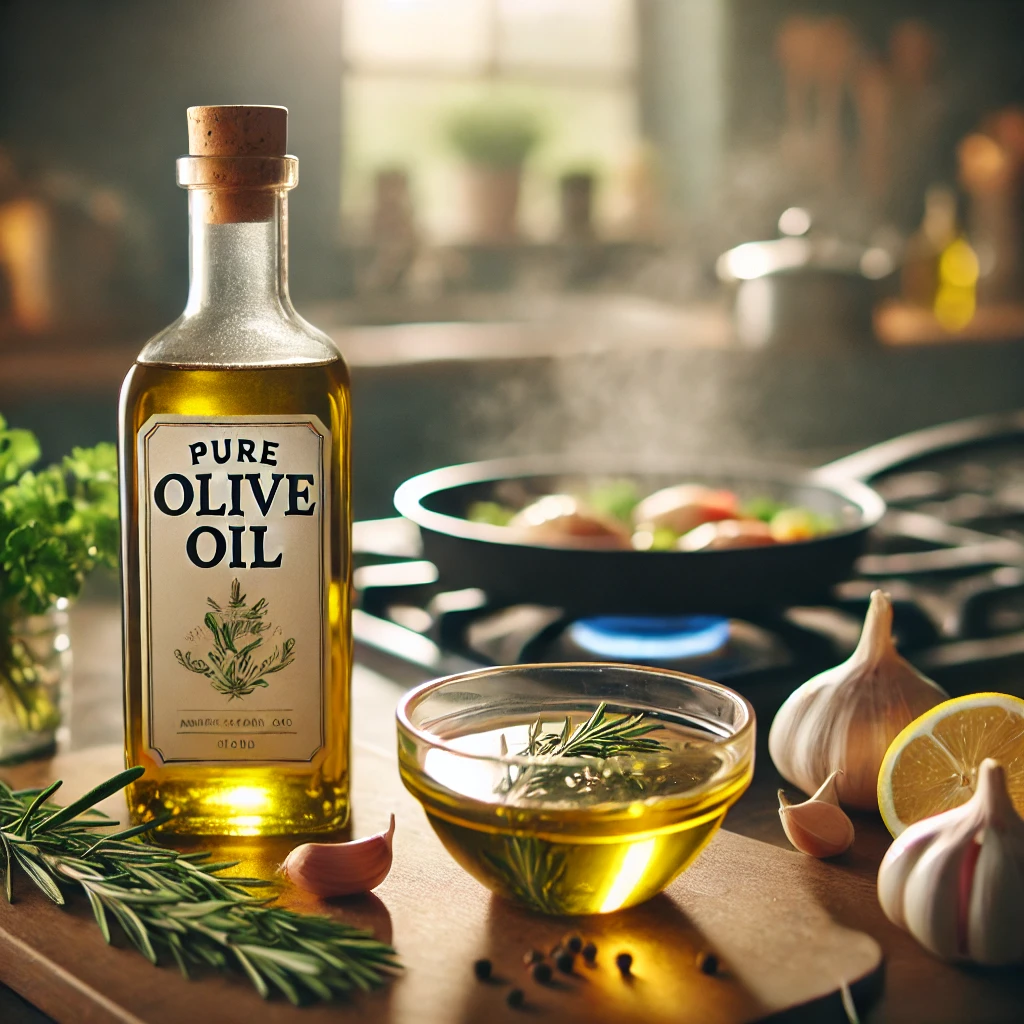
When it comes to olive oil, most people are familiar with extra virgin olive oil (EVOO), known for its rich flavor and high-quality extraction process. However, pure olive oil is often overlooked—despite offering many of the same health benefits as EVOO at a lower cost.
If you’re looking for a versatile, budget-friendly olive oil that still delivers quality and nutrition, pure olive oil is an excellent choice. In this blog, we’ll break down how it’s made, how it compares to other types of olive oil, and why it deserves a spot in your kitchen.
How Pure Olive Oil is Made
Pure olive oil is a blend of refined olive oil and a small percentage of extra virgin or virgin olive oil. Unlike EVOO, which is extracted solely through cold pressing, pure olive oil undergoes additional processing to remove impurities, neutralize strong flavors, and create a more consistent product.
Production Process:
- Harvesting & Crushing – Olives are harvested, washed, and crushed into a paste.
- Pressing & Extraction – Oil is extracted from the paste through mechanical pressing. Some oil at this stage is classified as EVOO or virgin olive oil.
- Refining Process – Lower-quality oil undergoes refining, which removes defects, excessive bitterness, and strong acidity. This results in a neutral-flavored oil.
- Blending – To restore some of the olive oil’s natural flavor and color, a small percentage of EVOO or virgin olive oil is blended in.
While the refining process removes some antioxidants and polyphenols, pure olive oil still retains many of the beneficial fatty acids found in EVOO.
Pure Olive Oil vs. Other Types of Olive Oil
| Type | Extraction Process | Flavor | Smoke Point | Best Uses | Price |
| Extra Virgin Olive Oil (EVOO) | Cold-pressed, unrefined | Bold, peppery, grassy | 375-405°F (190-207°C) | Drizzling, dressings, low-heat cooking | Most expensive |
| Virgin Olive Oil | Cold-pressed, lightly filtered | Milder than EVOO | 390-420°F (200-215°C) | Cooking, marinades | Mid-range |
| Pure Olive Oil | Refined + blended with virgin/EVOO | Light, neutral, mild olive taste | 410-450°F (210-232°C) | Sautéing, roasting, baking, frying | More affordable |
| Light Olive Oil | Highly refined | Very mild, nearly tasteless | 465°F (240°C) | High-heat frying, baking | Least expensive |
Key Differences & Similarities:
✅ Pure olive oil has a higher smoke point than EVOO, making it better suited for high-heat cooking like frying and roasting.
✅ It’s milder in flavor, so it won’t overpower delicate dishes and is the best oil to use when infusing herbs.
✅ It’s still rich in heart-healthy monounsaturated fats, which support cardiovascular health.
✅ It costs less than EVOO, making it a more affordable choice for everyday use.
Health Benefits of Pure Olive Oil
While EVOO contains the highest concentration of antioxidants and polyphenols, pure olive oil still offers many of the same benefits thanks to its healthy fat content.
🥑 Heart Health: Like EVOO, pure olive oil is rich in monounsaturated fats, which help reduce bad cholesterol (LDL) and support heart function.
🧠 Cognitive Support: Studies suggest that regular olive oil consumption—regardless of type—may help protect against cognitive decline and dementia.
🔥 Anti-Inflammatory Properties: While EVOO has the most antioxidants, pure olive oil still contains compounds that help reduce inflammation in the body.
🍳 Weight Management: The healthy fats in pure olive oil promote satiety, helping with portion control and reducing unhealthy cravings.
💪 Better Cooking Stability: Because of its refining process, pure olive oil is more resistant to oxidation at high temperatures compared to EVOO, making it a reliable choice for frying and roasting.
Best Ways to Use Pure Olive Oil in Cooking
Pure olive oil is one of the most versatile oils you can have in your kitchen. Unlike EVOO, which is best used raw or for low-heat cooking, pure olive oil works across a range of cooking methods:
✔ Sautéing & Stir-Frying – With its high smoke point, pure olive oil is ideal for quickly cooking vegetables, meats, and seafood.
✔ Roasting & Grilling – Drizzle over vegetables, chicken, or potatoes before roasting for a crisp, golden finish.
✔ Baking Substitute – Swap out butter or vegetable oil with pure olive oil in cakes, muffins, and bread for a moist, healthier option.
✔ Marinades & Dressings – While EVOO is preferred for raw applications, pure olive oil can be a budget-friendly option for marinades and mild-flavored dressings.
✔ Light Frying – Unlike EVOO, which burns at high temperatures, pure olive oil can be used for pan-frying or shallow frying without smoking.
Is Pure Olive Oil Right for You?
If you love the health benefits of olive oil but want a cost-effective option that can handle higher heat cooking, pure olive oil is an excellent choice. While it doesn’t have the bold, robust flavor of extra virgin olive oil, it’s a fantastic all-purpose oil that balances affordability, health benefits, and versatility.
At Garden Infuzions, we embrace pure olive oil for infusing herbs and flavors while maintaining a balance of nutrition and practicality. Whether you’re cooking, baking, or making marinades, pure olive oil delivers quality without breaking the bank.
